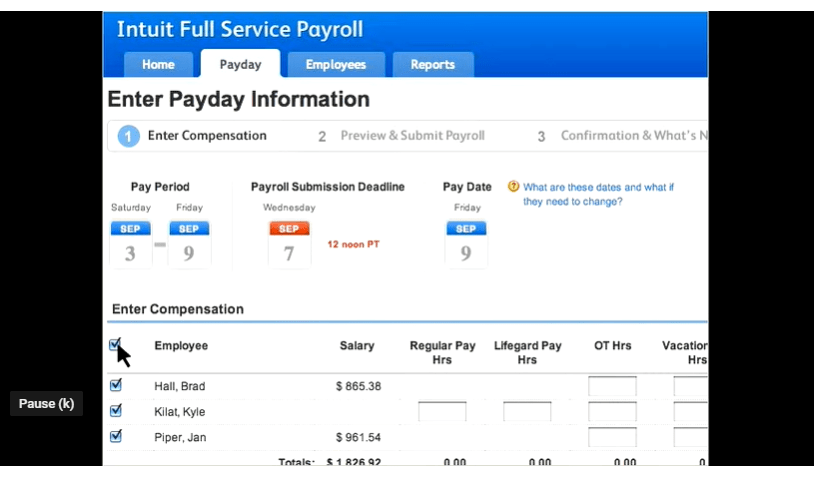
Minimal personal use (such as a stop for lunch between two business stops) is not an interruption of business use. An adequate record contains enough information on each element of every business or investment use. The amount of detail required to support the use depends on the facts and circumstances.
Sum-of-the-years’-digits (SYD) Method
You did not elect a section 179 deduction and the property is not qualified property for purposes of claiming a special depreciation allowance, so your property’s unadjusted basis is its cost, $10,000. You use GDS and the half-year convention to figure your depreciation. You refer to the MACRS Percentage Table Guide in Appendix A and find that you should use Table A-1. Multiply your property’s unadjusted basis each year by the percentage for 7-year property given in Table A-1. You figure your depreciation deduction using the MACRS Worksheet as follows.
Publication 946 ( , How To Depreciate Property
Alongside her accounting practice, Sandra is a Money and Life Coach for women in business. A fixed asset such as software or a database might only be usable to your business for a certain period of time. Asset needs to be fully amortized by the end of the usage period. New assets are typically more valuable than older ones for a number of reasons. Depreciation measures the value an asset loses over time—directly from ongoing use through wear and tear and indirectly from the introduction of new product models and factors like inflation. Writing off only a portion of the cost each year, rather than all at once, also allows businesses to report higher net income in the year of purchase than they would otherwise.
Calculating Depreciation Using the Straight-Line Method
Appendix A contains the MACRS Percentage Table Guide, which is designed to help you locate the correct percentage table to use for depreciating your property. However, a qualified improvement does not include any improvement for which the expenditure is attributable to any of the following. If you placed your property in service in 2023, complete Part III of Form 4562 to report depreciation using MACRS. Complete Section B of Part III to report depreciation using GDS, and complete Section C of Part III to report depreciation using ADS.
Depreciation of Long-Term Assets
The unadjusted depreciable basis of a GAA is the total of the unadjusted depreciable bases of all the property in the GAA. The unadjusted depreciable basis of an item of property in a GAA is the amount you would use to figure gain or loss on its sale, but figured without reducing your original basis by any depreciation allowed or allowable in earlier years. However, you do reduce your original basis by other amounts, including how to prepare and analyze a balance sheet +examples any amortization deduction, section 179 deduction, special depreciation allowance, and electric vehicle credit. The fraction’s numerator is the number of months (including parts of a month) in the tax year. You figure the depreciation rate under the SL method by dividing 1 by 5, the number of years in the recovery period. The result is 20%.You multiply the adjusted basis of the property ($1,000) by the 20% SL rate.

- You cannot use the MACRS percentage tables to determine depreciation for a short tax year.
- Therefore, Silver Leaf’s qualifying cost for the section 179 deduction is $520.
- To convert this from annual to monthly depreciation, divide this result by 12.
- You must also increase the 15-year safe harbor amortization period to a 25-year period for certain intangibles related to benefits arising from the provision, production, or improvement of real property.
- The IRS’s commitment to LEP taxpayers is part of a multi-year timeline that began providing translations in 2023.
You must generally depreciate the carryover basis of property acquired in a like-kind exchange or involuntary conversion over the remaining recovery period of the property exchanged or involuntarily converted. You also generally continue to use the same depreciation method and convention used for the exchanged or involuntarily converted property. This applies only to acquired property with the same or a shorter recovery period and the same or more accelerated depreciation method than the property exchanged or involuntarily converted. The excess basis (the part of the acquired property’s basis that exceeds its carryover basis), if any, of the acquired property is treated as newly placed in service property. When using a declining balance method, you apply the same depreciation rate each year to the adjusted basis of your property. You must use the applicable convention for the first tax year and you must switch to the straight line method beginning in the first year for which it will give an equal or greater deduction.
John, in Example 1, allows unrelated employees to use company automobiles for personal purposes. John does not include the value of the personal use of the company automobiles as part of their compensation and does not withhold tax on the value of the use of the automobiles. This use of company automobiles by employees is not a qualified business use.
For example, if you must depreciate the listed property using the straight line method, you must also depreciate the improvement using the straight line method. Special rules apply to figuring depreciation for property in a GAA for which the use changes during the tax year. Examples include a change in use resulting in a shorter recovery period and/or a more accelerated depreciation method or a change in use resulting in a longer recovery period and/or a less accelerated depreciation method.
Before making the computation each year, you must reduce your adjusted basis in the property by the depreciation claimed the previous year(s). If you dispose of residential rental or nonresidential real property, figure your depreciation deduction for the year of the disposition by multiplying a full year of depreciation by a fraction. The numerator of the fraction is the number of months (including partial months) in the year that the property is considered in service. If you sell or otherwise dispose of your property before the end of its recovery period, your depreciation deduction for the year of the disposition will be only part of the depreciation amount for the full year.

The section 179 deduction limits apply both to the partnership and to each partner. The partnership determines its section 179 deduction subject to the limits. If costs from more than 1 year are carried forward to a subsequent year in which only part of the total carryover can be deducted, you must deduct the costs being carried forward from the earliest year first. Step 8—Using $20,000 (from Step 7) as taxable income, XYZ’s actual charitable contribution (limited to 10% of taxable income) is $2,000. Step 4—Using $20,000 (from Step 3) as taxable income, XYZ’s hypothetical charitable contribution (limited to 10% of taxable income) is $2,000.
To figure your depreciation deduction, you must determine the basis of your property. To determine basis, you need to know the cost or other basis of your property. If you place property in service in a personal construction worker benefits that make the job more appealing activity, you cannot claim depreciation. However, if you change the property’s use to use in a business or income-producing activity, then you can begin to depreciate it at the time of the change.

Depreciation accounts for decreases in the value of a company’s assets over time. In the United States, accountants must adhere to generally accepted accounting principles (GAAP) in calculating and reporting depreciation on financial statements. GAAP is a set of rules that includes the details, complexities, carrying value how to calculate carrying value definition formula and legalities of business and corporate accounting. GAAP guidelines highlight several separate, allowable methods of depreciation that accounting professionals may use. Companies take depreciation regularly so they can move their assets’ costs from their balance sheets to their income statements.
The method that takes an asset’s expected life and adds together the digits for each year is known as the sum-of-the-years’-digits (SYD) method. For book purposes, most businesses depreciate assets using the straight-line method. See how the declining balance method is used in our financial modeling course.
For a detailed discussion of passenger automobiles, including leased passenger automobiles, see Pub. Deductions for listed property (other than certain leased property) are subject to the following special rules and limits. For this purpose, the adjusted depreciable basis of a GAA is the unadjusted depreciable basis of the GAA minus any depreciation allowed or allowable for the GAA. In June 2025, Make & Sell sells seven machines to an unrelated person for a total of $1,100. For information on the GAA treatment of property that generates foreign source income, see sections 1.168(i)-1(c)(1)(ii) and (f) of the regulations. You can use either of the following methods to figure the depreciation for years after a short tax year.
The furniture is 7-year property placed in service in the third quarter, so you use Table A-4. Finally, because the computer is 5-year property placed in service in the fourth quarter, you use Table A-5. Knowing what table to use for each property, you figure the depreciation for the first 2 years as follows. The following example shows how to figure your MACRS depreciation deduction using the percentage tables and the MACRS Worksheet. Use this convention for nonresidential real property, residential rental property, and any railroad grading or tunnel bore. Once you elect not to deduct a special depreciation allowance for a class of property, you cannot revoke the election without IRS consent.
You are considered as owning property even if it is subject to a debt. Although we can’t respond individually to each comment received, we do appreciate your feedback and will consider your comments and suggestions as we revise our tax forms, instructions, and publications. Don’t send tax questions, tax returns, or payments to the above address. Depreciation is generally reserved for assets that are expensive and regularly used. If an asset didn’t cost much, it makes little sense to depreciate it.
There is no unrecovered basis at the end of the recovery period because you are considered to have used this property 100% for business and investment purposes during all of the recovery period. You can claim the section 179 deduction and a special depreciation allowance for listed property and depreciate listed property using GDS and a declining balance method if the property meets the business-use requirement. To meet this requirement, listed property must be used predominantly (more than 50% of its total use) for qualified business use.
Passenger automobiles; any other property used for transportation; and property of a type generally used for entertainment, recreation, or amusement. An addition to or partial replacement of property that adds to its value, appreciably lengthens the time you can use it, or adapts it to a different use. An intangible property such as the advantage or benefit received in property beyond its mere value. It is not confined to a name but can also be attached to a particular area where business is transacted, to a list of customers, or to other elements of value in business as a going concern. Travel between a personal home and work or job site within the area of an individual’s tax home.
A business can expect a big impact on its profits if it doesn’t account for the depreciation of its assets. Depreciation is a fixed cost using most of the depreciation methods, since the amount is set each year, regardless of whether the business’ activity levels change. The tax depreciation method follows rules set by the tax authorities in different jurisdictions. For instance, the IRS provides compliance guides on allocating depreciation costs of assets. A company can use depreciation methods to spread the cost of an asset.
Assume for all the examples that you use a calendar year as your tax year. If you elect not to apply the uniform capitalization rules to any plant produced in your farming business, you must use ADS. You must use ADS for all property you place in service in any year the election is in effect. See the regulations under section 263A of the Internal Revenue Code for information on the uniform capitalization rules that apply to farm property. Depreciate trees and vines bearing fruits or nuts under GDS using the straight line method over a recovery period of 10 years.